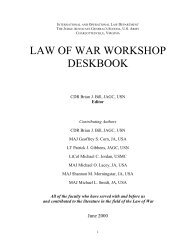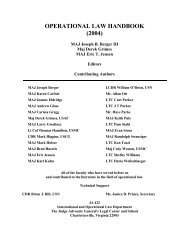learning with professionals - Higgins Counterterrorism Research ...
learning with professionals - Higgins Counterterrorism Research ...
learning with professionals - Higgins Counterterrorism Research ...
Create successful ePaper yourself
Turn your PDF publications into a flip-book with our unique Google optimized e-Paper software.
Regardless of its use, “no piece of evidence can be used in the state in which it is<br />
found.” 86 Whenever an analyst considers new evidence, the critical mind must follow a<br />
systematic interrogatory:<br />
Are these data genuine?<br />
How do I know?<br />
What does this evidence state or imply?<br />
Who is its author or maker and what degree of access does he have? 87<br />
What is the relation in time and space between the author and the information,<br />
overt or implied, that is conveyed by the information?<br />
How does the statement compare <strong>with</strong> other statements on the same point?<br />
What do we know independently about the author and his credibility? 88<br />
The product of critical inquiry is a judgment about the credibility and reliability of the<br />
evidence and its source. 89 Credibility (a measure of confidence) is only partly based on<br />
reliability (a measure of consistency), since past performance is never perfectly repeated.<br />
Pertinent data may not be available when an analyst begins to verify a piece of evidence.<br />
Under these circumstances, common sense and educated guesswork may be the<br />
only means of answering the questions asked in the evaluation of evidence. The specific<br />
basis of the answers is important and must be recorded. In this way, resort to intuition as<br />
the basis for decisionmaking is avoided. The key to the process is not that all of the<br />
answers to the inquiry are based on fully verified facts; rather, that the process is systematic<br />
and each answer is documented.<br />
Systematic Analytical Method. When an analyst systematically verifies data, authenticates<br />
a source, or accepts the likelihood of a hypothesis, important benefits ensue if the<br />
details of the process are recorded. Aside from serving as a paper trail that proves an evaluation<br />
was accomplished, documentation will hold crucially important information: the degree<br />
of rigor involved, what was known and unknown, what the analyst had confidence or doubts<br />
in, and a level of plausibility or acceptability of the evidence. A record of the manner in<br />
which the analyst evaluated the evidence also exposes the analyst’s assumptions and values<br />
for consistent application when other evidence arises. Finally, these records can be available<br />
for periodic review and reassessment by both the analyst and others who need to understand<br />
the analyst’s line of reasoning to evaluate the acceptability of the conclusions.<br />
86 Barzun and Graff, 156.<br />
87 There are four levels of verifiability: personal observations, reports, inferences, and assumptions. These<br />
levels correspond to the directness of the source to the information being reported. Karl Albrecht, Brain Power:<br />
Learn to Improve Your Thinking Skills (Englewood Cliffs, New Jersey: Prentice-Hall, 1980), 121.<br />
88 Barzun and Graff, 157-158.<br />
89 Credibility is a level of confidence in someone’s or something’s credit-worthiness. Reliability refers to the<br />
repeatability, including intrasubjective replicability, of observation. Suppose a technical surveillance system or<br />
human source produces approximately the same set of responses on repeated trials (and <strong>with</strong> different analysts<br />
or debriefers), we can say that the observational technique/source has high reliability, regardless of the actual<br />
validity of the findings. Pertti J. Pelto, Anthropological <strong>Research</strong>: The Structure of Inquiry (New York: Harper<br />
and Row, 1970), 42.<br />
60

















